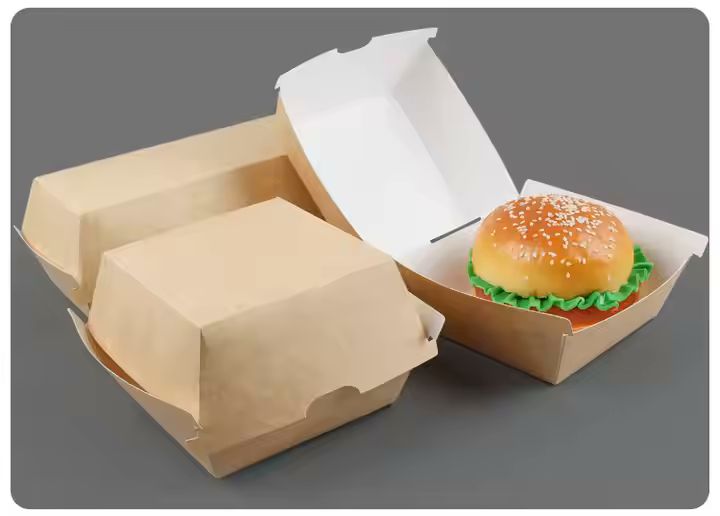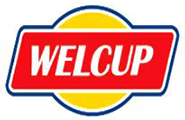In the fast-paced world of fast food and takeout dining, packaging plays a pivotal role in balancing functionality, aesthetics, and environmental responsibility. Among the most ubiquitous and transformative innovations in this space is the paper hamburger box. This unassuming yet revolutionary container has redefined how burgers are packaged, delivered, and enjoyed, all while addressing growing concerns about sustainability. This article explores the manufacturing process of paper hamburger boxes, their practical advantages, and their profound environmental significance.

The Manufacturing Process of Paper Hamburger Boxes
The creation of a paper hamburger box is a blend of engineering precision, material science, and environmental consciousness. Here’s a step-by-step breakdown of how these boxes are made:
1. Raw Material Sourcing
The journey begins with the selection of raw materials. Most paper hamburger boxes are crafted from kraft paper, a durable and biodegradable material derived from wood pulp. To align with sustainability goals, manufacturers often source pulp from responsibly managed forests certified by organizations like the Forest Stewardship Council (FSC). Some boxes incorporate recycled paper content, further reducing their environmental footprint.
2. Pulp Processing
The wood pulp undergoes a chemical or mechanical pulping process to break down the fibers. In chemical pulping, lignin (a natural binder in wood) is dissolved using chemicals like sodium hydroxide, resulting in strong, long fibers ideal for sturdy packaging. Mechanical pulping, which grinds wood into fibers, is less common for food-grade packaging due to residual lignin, which can compromise longevity.
3. Paperboard Production
The processed pulp is then formed into paperboard sheets. These sheets are pressed, dried, and rolled into large reels. For hamburger boxes, the paperboard is typically bleached or unbleached, depending on aesthetic preferences. Unbleached kraft paper retains its natural brown hue, signaling an eco-friendly choice, while bleached versions offer a crisp white finish for branding flexibility.
4. Coating for Functionality
To ensure grease and moisture resistance—critical for holding juicy burgers—the paperboard is often coated with a thin layer of food-safe materials. Traditional coatings like polyethylene (PE) have been widely used but are now being replaced by biodegradable alternatives such as polylactic acid (PLA), a plant-based polymer derived from cornstarch. This shift eliminates reliance on fossil fuels and enhances compostability.
5. Die-Cutting and Shaping
The coated paperboard is fed into die-cutting machines, which stamp out flat templates shaped like hamburger boxes. These templates are precision-engineered to fold into three-dimensional containers effortlessly. Embossing or debossing techniques may add textures or brand logos at this stage.
6. Assembly and Quality Control
The flat templates are folded into their final box shape using automated machinery. Adhesives or interlocking tabs secure the seams. Quality control checks ensure that boxes are leak-proof, structurally sound, and free of contaminants. Boxes are then stacked, packaged, and shipped to food service providers.
The Convenience of Paper Hamburger Boxes
Paper hamburger boxes have become indispensable in the food industry due to their versatility and user-friendly design. Below are key advantages that make them a favorite among businesses and consumers:
1. Lightweight and Portable
Unlike bulky plastic containers, paper hamburger boxes are lightweight, reducing transportation costs and carbon emissions. Their compact design allows for easy stacking, optimizing storage space in kitchens and delivery vehicles.
2. Heat Retention and Breathability
The insulating properties of paperboard help retain heat, keeping burgers warm during transit. At the same time, the material’s breathability prevents condensation buildup, which can soggy buns—a common issue with plastic packaging.
3. Customizable Branding
Paper’s printable surface offers a canvas for branding. Restaurants can imprint logos, slogans, or QR codes directly onto boxes, turning packaging into a marketing tool. Vibrant colors and finishes (e.g., matte or glossy) enhance visual appeal, aligning with brand identities.
4. Easy Assembly and Disposal
Pre-folded designs enable quick assembly during busy service hours. For consumers, disposal is hassle-free: boxes can be flattened for recycling or composted (if coated with biodegradable materials), minimizing post-meal cleanup.
5. Versatility Beyond Burgers
While designed for burgers, these boxes are adaptable. They can hold sandwiches, wraps, fried chicken, or even desserts like pancakes and pastries, making them a multipurpose solution for diverse menus.
The Environmental Imperative of Paper Hamburger Boxes
The shift toward paper-based packaging is not just a trend—it’s a response to the global plastic pollution crisis. Here’s how paper hamburger boxes contribute to a greener future:
1. Biodegradability and Compostability
Unlike plastic, which persists in landfills for centuries, paper hamburger boxes decompose naturally within weeks to months under composting conditions. PLA-coated boxes break down into water, carbon dioxide, and organic matter, leaving no toxic residues.
2. Reduced Carbon Footprint
The production of paperboard generates fewer greenhouse gases compared to plastic manufacturing. Additionally, FSC-certified paper ensures that forests are replenished, maintaining carbon sequestration capabilities.
3. Recyclability
Uncoated or PLA-coated paper boxes can be recycled with other paper products, closing the loop in a circular economy. This reduces demand for virgin materials and lowers energy consumption.
4. Consumer Demand for Sustainability
A 2023 Nielsen report revealed that 73% of global consumers are willing to pay more for sustainably packaged products. By adopting paper hamburger boxes, businesses align with eco-conscious values, enhancing brand loyalty among environmentally aware customers.
5. Regulatory Compliance
Governments worldwide are enacting bans on single-use plastics. The European Union’s Single-Use Plastics Directive and similar laws in Canada, Australia, and U.S. states like California incentivize the adoption of paper alternatives.
Case Studies: Success Stories in Sustainable Packaging
McDonald’s Global Shift: In 2022, McDonald’s announced plans to replace all plastic-based packaging with recycled or renewable materials by 2025. Their paper hamburger boxes, now used in 90% of global markets, have already reduced plastic waste by 1.5 million tons annually.
Shake Shack’s Compostable Packaging: The popular burger chain transitioned to PLA-coated paper boxes in 2020, diverting 80% of its packaging waste from landfills through composting partnerships.
Local Pizzeria Innovations: Small businesses are also embracing paper boxes. A Brooklyn-based burger joint reported a 30% increase in customer satisfaction scores after switching to branded, compostable packaging.
Challenges and Future Innovations
While paper hamburger boxes offer immense benefits, challenges remain. The higher cost of biodegradable coatings and limited composting infrastructure in some regions hinder widespread adoption. However, advancements in material science—such as water-based barrier coatings and nanocellulose composites—promise to enhance functionality while lowering costs. Partnerships between governments, manufacturers, and waste management companies will be critical to scaling eco-friendly solutions.
Conclusion
The paper hamburger box is more than a container—it’s a symbol of progress in the intersection of convenience, commerce, and environmental stewardship. From responsibly sourced pulp to compostable coatings, every stage of its production reflects a commitment to sustainability. As consumers and regulators demand greener alternatives, this humble packaging solution stands as a testament to what’s possible when innovation meets ecological responsibility. For businesses, adopting paper hamburger boxes isn’t just a choice; it’s an opportunity to lead the charge toward a waste-free future—one burger at a time.

